Yongmunsa Temple In
Yongmunsan Mountain
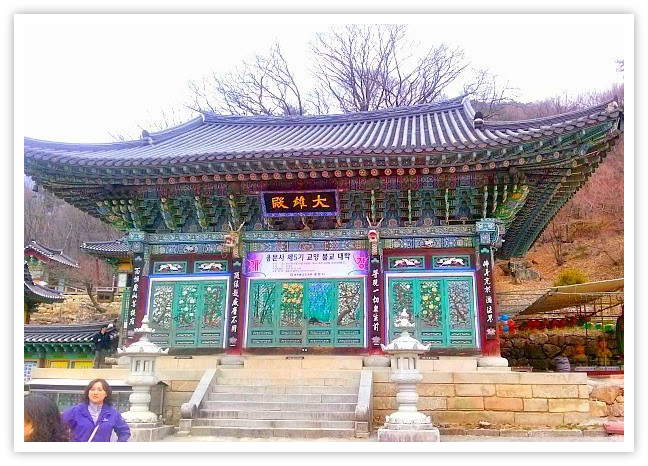 Yongmunsa Temple in Yongmunsan (mountain) - Daeungjeon (main Dharma Hall)
Yongmunsa Temple in Yongmunsan (mountain) - Daeungjeon (main Dharma Hall)Yongmunsa Temple in Yongmunsan
Venture into the serenity of nature and spirituality at Yongmunsa Temple in Yongmunsan, a significant cultural landmark nestled in the heart of Gyeonggi Province, South Korea.
Founded during the reign of King Injo of the Goryeo Dynasty in the 10th century, this ancient Buddhist temple is a testament to South Korea's deep-rooted religious history and architectural grandeur.
Surrounded by the enchanting beauty of Mt. Yongmun, the temple is home to several cultural treasures, including the Yongmunsa Daeungjeon Hall, a designated National Treasure. Its architectural beauty lies in the harmony of intricate woodwork, elegant stone pagodas, and the vibrant colors of traditional dancheong decorations.
Perhaps the most awe-inspiring sight is the Thousand-Year-Old Ginkgo Tree, considered one of the largest and oldest in the world. In autumn, the temple ground transforms into a golden spectacle as the tree sheds its leaves.
As a spiritual retreat, Yongmunsa Temple in Yongmunsan offers temple stay programs where visitors can experience the tranquility of Buddhist life through meditation, tea ceremonies, and lantern making.
Whether you're a history enthusiast, a nature lover, or a spiritual seeker, Yongmunsa Temple offers a journey of discovery, peace, and serenity amidst the captivating backdrop of South Korea's scenic landscapes.
Yongmunsa Temple (용문사, 용문산)
Yongmunsa Temple (or Yongmun Temple; ‘sa’ means a temple in Korean language or character). This national historical treasure makes it one of the most visited properties in the area.
I am proud to say that I’ve been there – for a day only! A great environment to get physically, mentally, and spiritually invigorated.
Yes, I've been to this old Yongmun Temple and the mountain where this beautiful place nestles. Undoubtedly, it was an experience-of-a-lifetime for me. The site is peaceful, tranquil, beautiful, and a great place to be, even for a short while, because of the clean environment, air, green plants and all.
It is an excellent place for friends and family to visit for a day. Moreover, I recommend it as one of the best places to explore in the area. You can get to this place via train, bus, taxi or personal vehicle.
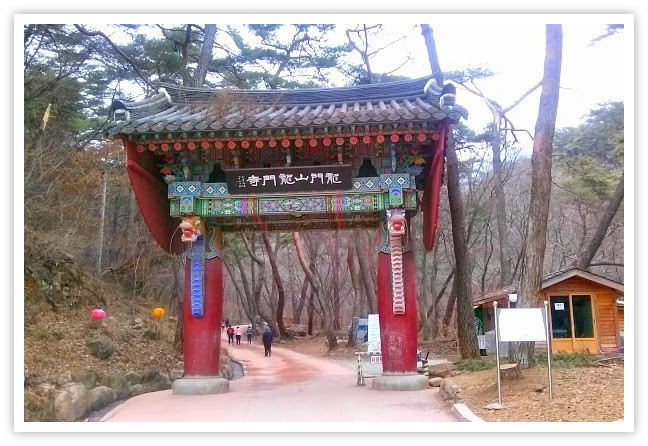 Notice the two pillars supporting the gate's roof of Yongmunsa Temple in Yongmunsan. Only during the Joseon period did that kind of structure be built.
Notice the two pillars supporting the gate's roof of Yongmunsa Temple in Yongmunsan. Only during the Joseon period did that kind of structure be built.the entrance
However, before you get into that temple area, you might want to look around first at the entrance area of this park. By the way, you need to pay for an entrance fee. Don't worry it's not expensive.
Okay, here's what you will see at the entrance area. I suggest you take something or eat something first before you start your hike up to that mountain. It's not a strenuous walk, but it would be good if you're not hungry when going there.
Right before the entrance, you can find various restaurants most of them offer healthy traditional Korean food. We had a meal after our tour and not before that.
Now, as you start your walk, you'll see this main gate right before you enter a narrower pathway (or road) that will lead you to the foot of Yongmun Mountain. It is a gentle and pleasant walk, so no need to sweat it.
If you don't have a leg problem, you can easily walk this concrete road and start hiking until you reach the temple. It's only about 1.5 kilometers to the temple.
Along the way, you will notice one or two shops that try to promote Buddhism symbols for those who interested in getting one. I'm sure they are works of arts and personally like them.
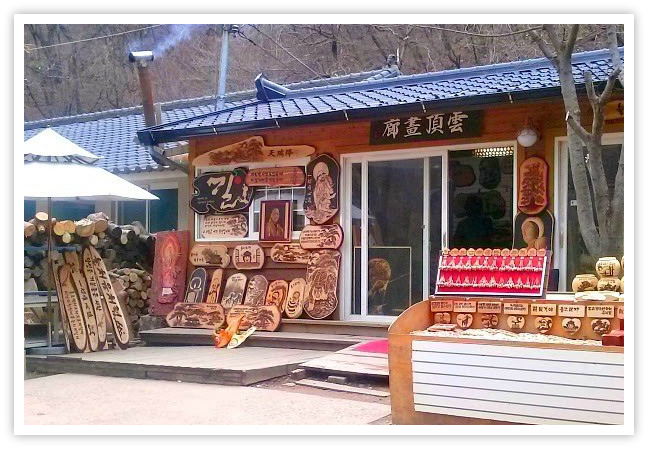 Yongmunsa souvenir shop
Yongmunsa souvenir shopYongmun Temple (용문사)
Let's take a look at this temple. According to history, it was built during the reign of King Sejong, of the Joseon Dynasty during the Shilla Kingdom. Just like most of the structures all over Korea, this very temple has also been severely damaged.
After the Korean War, the temple was being restored and has now three buildings, among them is the bell tower--not really a tower because it is only a traditional roof to protect the bell itself from the elements.
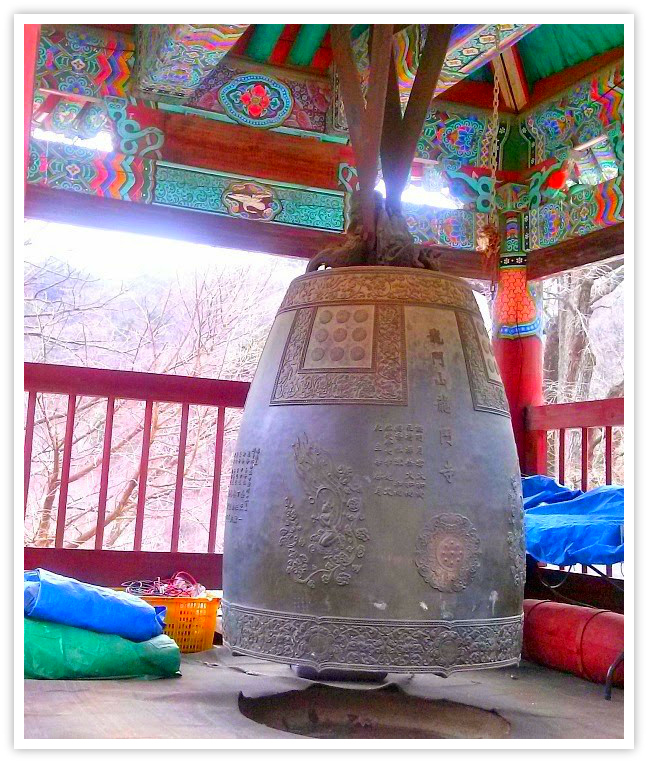 Huge Yongmunsa Temple Bell in the pavilion
Huge Yongmunsa Temple Bell in the pavilionLooking at the photo, you will see a hole right below the bell's opening. It functions as a vibrator making its sound reverberate louder and longer. It's a beautiful treasure and a piece of religious art relic.
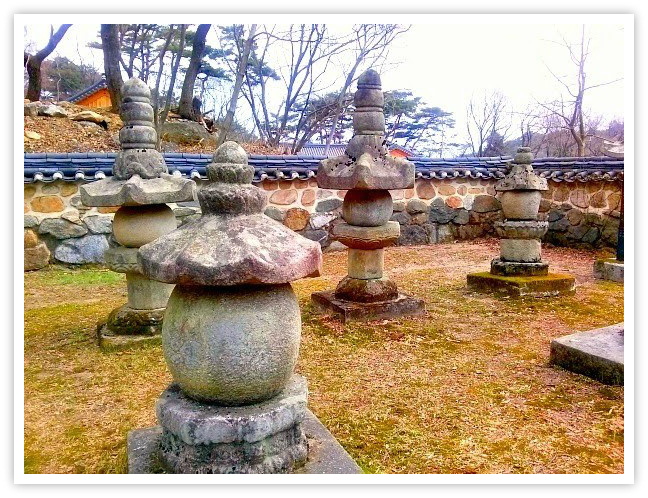 Graveyard for monks and their 'sari' (stone remains that symbolizes their holiness)
Graveyard for monks and their 'sari' (stone remains that symbolizes their holiness)Do you know what those standing circular carved stones are? They are bigger versions of cremated ash containers. Right, they contain the ashes of monks who spent their lives and died in this place.
My colleagues told me that Japanese soldiers had removed some of these during the occupation period. I have to know where they brought or what they do with them.
1,000-year old gingko tree
What I really enjoyed like in the area is the existence of an ancient gingko tree. It was really huge, and you can tell by looking at it that it is really old and it's a witness to everything that happened around it.
This gingko tree is about 1,100 years old and is thought to be the oldest one in the East. It stands 60 meters high and about 14 meters in circumference. Of course, it is designated and protected as a natural monument.
A legend says that a great monk stuck his staff into the ground and it grew into a gigantic tree--this gingko tree!
TRIVIA: This ancient Gingko Tree is approximately over 1,000 years old. A legend has it that a holy monk's staff turned into this tree!
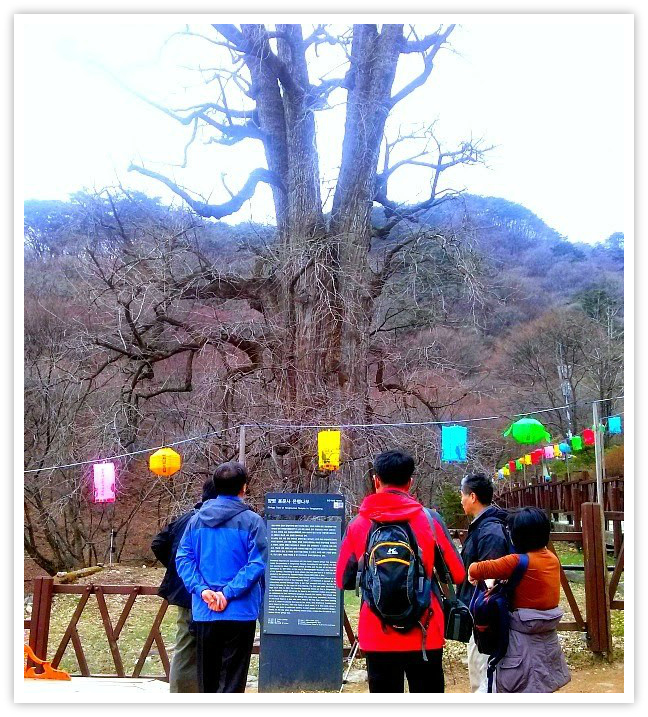 An ancient Gingko Tree inside the temple area
An ancient Gingko Tree inside the temple areabuddha's statue
As I tried to enjoy the place, I look around and found an enclosed temple where the monks pray and meditate. I looked around to find out if somebody is watching the area but noticed that nobody is around and so I went inside.
It's was a cozy and tranquil place. It is the right place to pray, meditate, reflect and experience the unseen power of the divine. ^^
Right inside that temple sits an old statue of Buddha. I don't know how old but it is an important holy space where the monks of Yongmunsa Temple spend the time to pray. Although I am a Christian believer, I paid my respects and offered a short prayer.
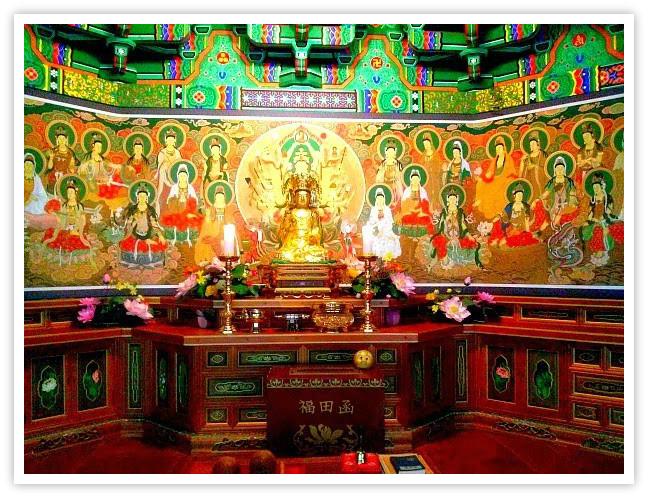 Vairocana Buddha statue
Vairocana Buddha statueFresh Spring Water & Wishing Well
You don’t have to bring up drinking water if you can wait until you reach the temple. That is because there is a fresh, clean, and free-flowing spring water. Monks and visitors drink this fresh water flowing out from the mountain.
The channeled freshwater flows into a well. You can see coins thrown into it by visitors. I believe this well serves as a donation ‘well’ for the temple.
For fun, I threw in a coin but did not make it! Practice makes perfect, as you say!
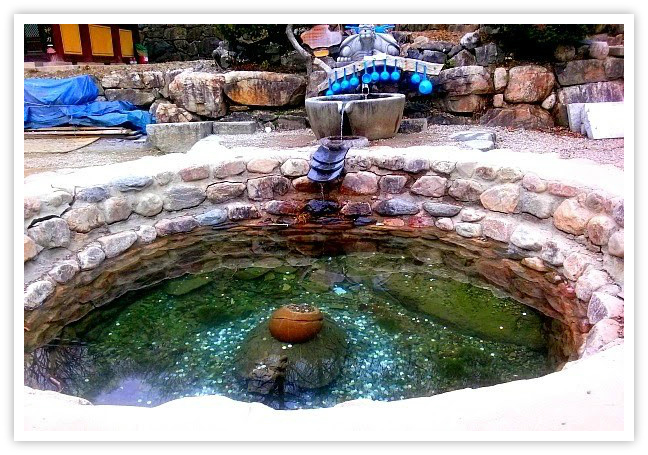 Fresh drinking water and Wishing Well
Fresh drinking water and Wishing Wellwhere to eat?
Before entering into the area, you will see stores and restaurants lined up along the way towards the main entrance of Yongmunsa Temple ground.
Together with friends or family, you can either drop by at any of the restaurants before or after your mountain hiking activity.
My colleagues and I enjoyed one of the restaurant’s varied menu and a few shots of a local drink (makkoli). We enjoyed it as we return from our educational hike (we call it a ‘workshop’ by the way).
At the stores, you can pack your backpacks with kimbap and other food and drinks before going up. There are no designated places to eat, but you can find some comfortable areas somewhere in the mountain. Be sure to leave nothing behind.
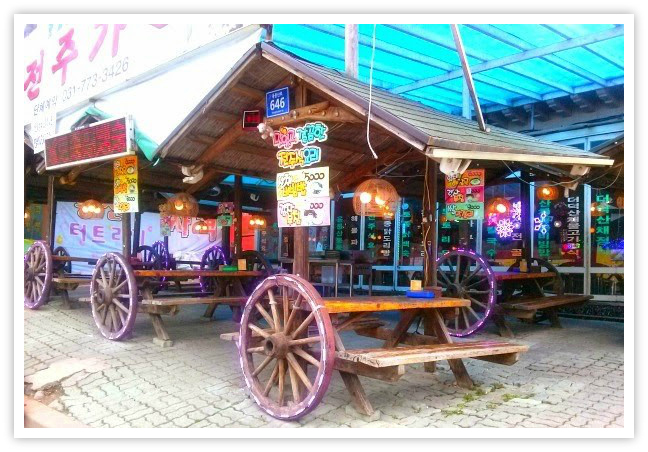 Cafe's and Restaurants abound at the front area of Yongmunsa
Cafe's and Restaurants abound at the front area of Yongmunsasouvenir shops
Midway towards the temple, you will find shops selling various products including souvenirs. These souvenir shops sell works of art, including wood carvings. The wood carvings could be religious in nature, that is, Buddhism religion.
Aside from the souvenirs, you can also purchase light food and drinks in case you miss to bring up with you from the shops below.
Who Can Visit Yongmunsa Temple
I reckon that any physically non-disabled person (or animals, if you are bringing your pet dog if you got one).
I think that very your children (ages 1 to 6 years old) are not fit to hike by themselves up to the temple. That is because starting from the unpaved pathway (road), although the elevation is not stiff, it could be difficult for kids with such ages. Unless adults carry them to the temple ground, then there will be no problem at all.
However, kids from around seven and adults can easily hike up to the temple where they can rest and breathe the fresh air.
For adults, I would recommend to all enthusiasts except to those with significant heart or breathing issues. However, generally, the path going up the mountain is spacious, safe, and great for hiking.
However, I warn the serious hikers to take further routes and beyond the temple, as you might get disappointed realizing it is short.
If you are seriously considering to visit the place, you may use the information below.
getting to yongmunsa temple
Yongmunsa Temple In Yongmunsan (용문사 - 용문산)
- Address: 416, Yongmunsan-ro, Yongmun-myeon, Yangpyeong-gun, Gyeonggi-do
- Website: www.yongmunsa.org (Korean language only)
- Inquiries: +82-31-1330 (Korean, English, Japanese, Chinese)
- Business Hours: 8:00am to 5:00pm
- Admission Fees: Adults-2,000/group-1,800KRW; Youth-1,400/1,200; Children-1,000,/800; Below 7 years old is free
- Bus: From Seoul to Yongmun, buses are available at Sangbong and East Seoul Terminal. It takes 1 hour to get there.
Thanks for reading and please share if this is helpful! :)
- Home
- Temples in South Korea
- Yongmunsa Temple In Yongmunsan
Get Exciting Activities
Book one of our exciting activities today to experience the thrill of a lifetime! Take advantage of this opportunity and secure your spot in advance.
Hotel Map Guide
Find your affordable, accessible, and comfortable hotel in Seoul at Agoda.Com. See the hotel map below...
Hotel Booking Guide
Find affordable and amazing hotels on Agoda.com using the search box below. Book now to enjoy great discounts and save!
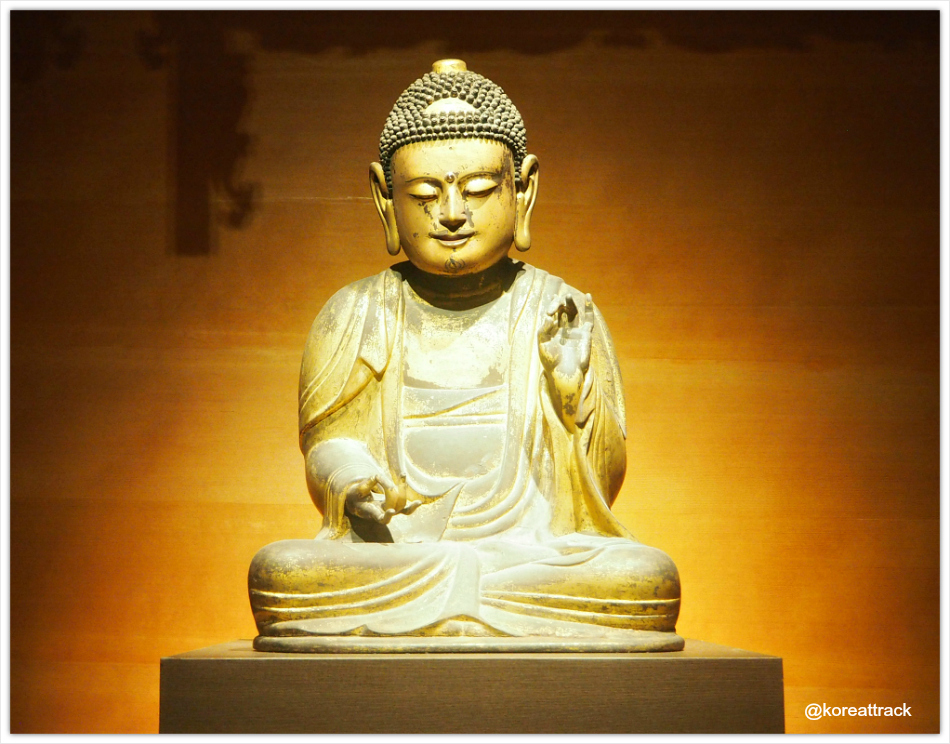
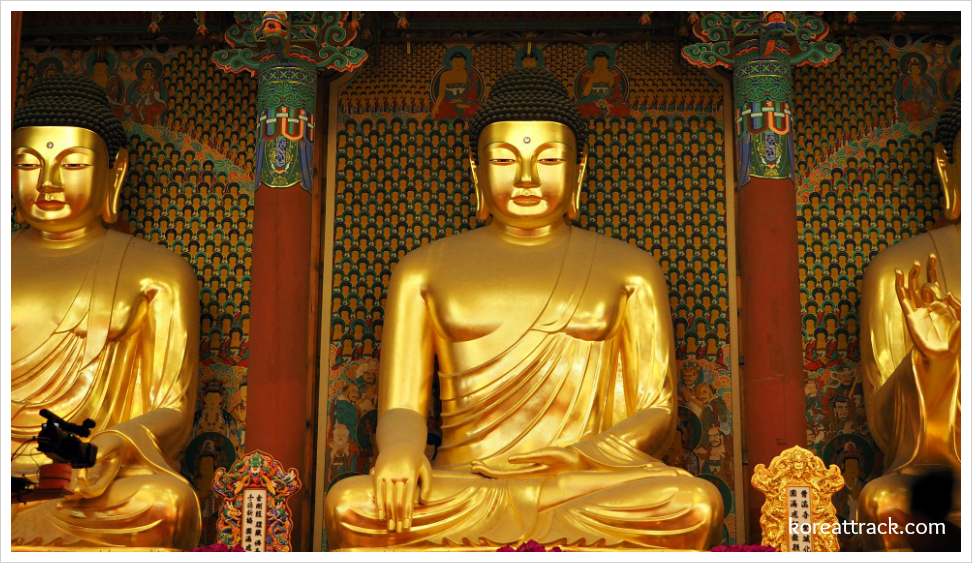
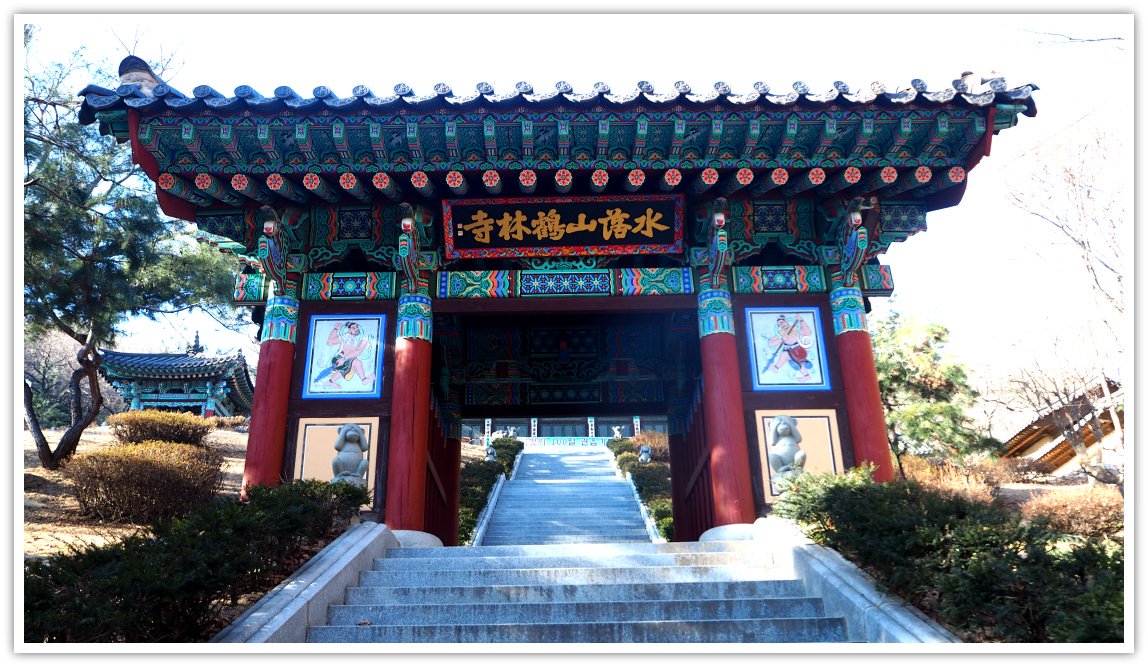


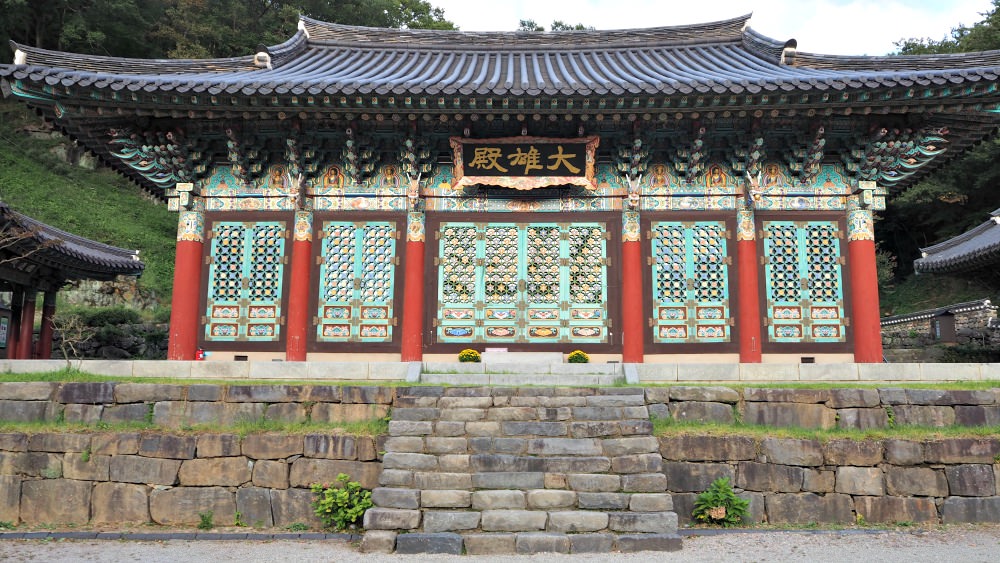




New! Comments
What do you think about this page? Leave me a comment in the box below.